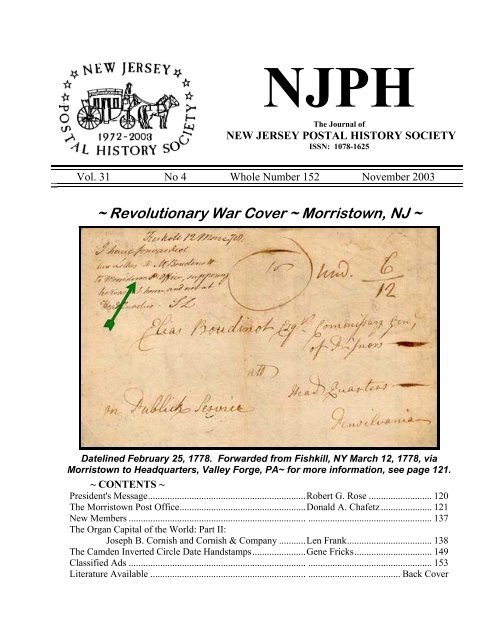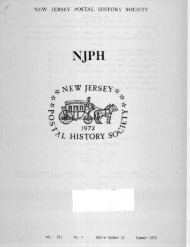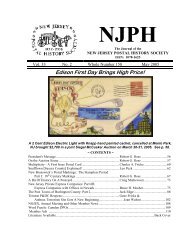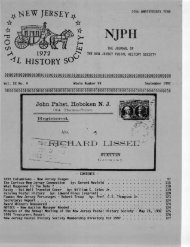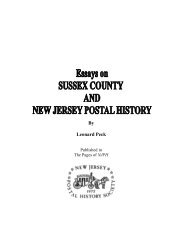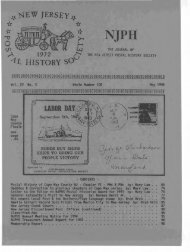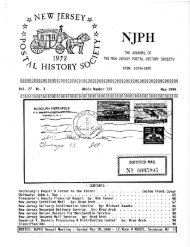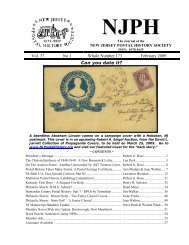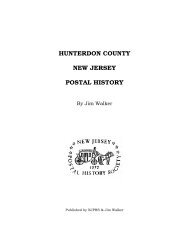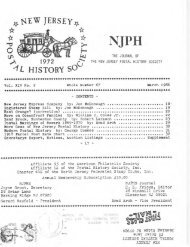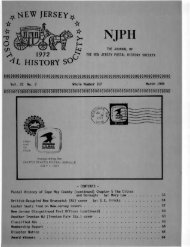Morristown, NJ - New Jersey Postal History Society
Morristown, NJ - New Jersey Postal History Society
Morristown, NJ - New Jersey Postal History Society
You also want an ePaper? Increase the reach of your titles
YUMPU automatically turns print PDFs into web optimized ePapers that Google loves.
<strong>NJ</strong>PH<br />
The Journal of<br />
NEW JERSEY POSTAL HISTORY SOCIETY<br />
ISSN: 1078-1625<br />
Vol. 31 No 4 Whole Number 152 November 2003<br />
~ Revolutionary War Cover ~ <strong>Morristown</strong>, <strong>NJ</strong> ~<br />
Datelined February 25, 1778. Forwarded from Fishkill, NY March 12, 1778, via<br />
<strong>Morristown</strong> to Headquarters, Valley Forge, PA~ for more information, see page 121.<br />
~ CONTENTS ~<br />
President's Message.................................................................Robert G. Rose .......................... 120<br />
The <strong>Morristown</strong> Post Office....................................................Donald A. Chafetz ..................... 121<br />
<strong>New</strong> Members ......................................................................... ................................................... 137<br />
The Organ Capital of the World: Part II:<br />
Joseph B. Cornish and Cornish & Company ...........Len Frank................................... 138<br />
The Camden Inverted Circle Date Handstamps......................Gene Fricks................................ 149<br />
Classified Ads ......................................................................... ................................................... 153<br />
Literature Available ................................................................ ...................................... Back Cover
NEW JERSEY POSTAL HISTORY SOCIETY, INC.<br />
APS Affiliate #95 - PHS Affiliate #1A - <strong>NJ</strong>FSC Chapter #44S ISSN: 1078-1625<br />
Annual Membership Subscriptions $15.00<br />
Website: http://www.njpostalhistory.org<br />
or enter “<strong>NJ</strong>PHS” in your browser's search window and go from there.<br />
OFFICERS<br />
President: Robert G. Rose, P.O. Box 1945, <strong>Morristown</strong>, <strong>NJ</strong>. 07062-1945 rrose@PitneyHardin.com<br />
Vice President and Editor Emeritus: E.E. Fricks, 25 Murray Way, Blackwood, <strong>NJ</strong> 08012<br />
Treasurer: Andrew Kupersmit, <strong>New</strong> <strong>Jersey</strong> <strong>Postal</strong> <strong>History</strong> <strong>Society</strong>, Inc., C/o Robert A. Siegel<br />
Auction Galleries Inc., 60 East 56 th Street, 4 th floor, <strong>New</strong> York, NY 10022<br />
Secretary: Jean R. Walton, 125 Turtleback Rd., Califon, <strong>NJ</strong> 07830 Njpostalhistory@aol.com<br />
Auction Manager: Arne Englund, PO Box 57, Port Murrary, <strong>NJ</strong> 07865 alenglund@aol.com<br />
Editor-in-Chief/<strong>NJ</strong>PH Robert G. Rose, P.O. Box 1945, <strong>Morristown</strong>, <strong>NJ</strong>. 07062-1945<br />
rrose@PitneyHardin.com<br />
Layout Editor Jean R. Walton, 125 Turtleback Rd., Califon, <strong>NJ</strong> 07830 Njpostalhistory@aol.com<br />
****************************************************************************<br />
2004 MEMBERSHIP DUES<br />
It’s that time of the year again. Enclosed with this issue of <strong>NJ</strong>PH is your <strong>Society</strong><br />
membership dues notice for 2004. Against rising costs for copying and mailing <strong>NJ</strong>PH to you,<br />
the <strong>Society</strong> has held dues to $15.00 per year. Please consider a tax-deductible contribution with<br />
your dues payment before year’s end. It will go a long way to ensuring the <strong>Society</strong>’s economic<br />
well being in the year to come. Dues should be sent to our Treasurer, Andy Kupersmit at <strong>New</strong><br />
<strong>Jersey</strong> <strong>Postal</strong> <strong>History</strong> <strong>Society</strong>, Inc., C/o Robert A. Siegel Auction Galleries Inc., 60 East 56 th<br />
Street, 4 th floor, <strong>New</strong> York, NY 10022. Remember that each paid up member is entitled to place<br />
two free classified ads per year in <strong>NJ</strong>PH. Please be sure to fill out the enclosed form and return it<br />
to our Secretary, Jean Walton at 125 Turtleback Rd., Califon, <strong>NJ</strong> 07830.<br />
****************************************************************************<br />
PRESIDENT’S MESSAGE<br />
We have a new treasurer! Andrew Kupersmit has graciously agreed to take over the<br />
position. Andy is a professional philatelist with the Robert A. Siegel Auction Galleries and has a<br />
broad interest in all of <strong>New</strong> <strong>Jersey</strong>’s postal history. We wish him well. As his first order of<br />
business for the <strong>Society</strong>, he will be collecting dues for 2004. Please be sure to forward your dues<br />
promptly to him before the end of the year.<br />
We have received a special invitation to participate in the Empire State <strong>Postal</strong> <strong>History</strong><br />
<strong>Society</strong>’s “Exhibitor Challenge” which will be held at ROPEX 2004 in Rochester, <strong>New</strong> York on<br />
June 18-20, 2004. I plan on exhibiting at this show and hope that other members will also<br />
participate so that <strong>New</strong> <strong>Jersey</strong>’s postal history makes a nice showing. Because space fills up<br />
quickly, if you have an interest in exhibiting either a multi or single frame exhibit, be sure to visit<br />
the ROPEX website for a prospectus: www.geocities.com/rpastamps/ropex__pro.html or write<br />
ROPEX 2004 Exhibit Chairman, 42 Maynard Street, Rochester, <strong>New</strong> York 14615-2022.<br />
ROBERT G. ROSE<br />
<strong>NJ</strong>PH Vol. 31/No. 4<br />
November 2003 120<br />
Whole No. 152
THE MORRISTOWN POST OFFICE<br />
Donald A. Chafetz ~ THE MORRISTOWN POST OFFICE<br />
by Donald A. Chafetz<br />
The story of the <strong>Morristown</strong> Post Office stretches back to the very beginning of the Revolutionary<br />
War. Washington’s three encampments in <strong>Morristown</strong> starting in 1777 placed the small community of<br />
250 souls in the middle of the war, and consequently created a need for a post office.<br />
The origin of the post office in 1777 is a little murky, but has been pieced together from a number<br />
of sources. The post office seems to have functioned until the end of the war in 1780, and then slips<br />
from sight, reappearing in the records around 1792.<br />
Once it was firmly established under the Constitution government in 1792, its history is<br />
uneventful except for the numerous moves it made between the 1840’s to the 1860’s. The history of<br />
these moves has been pieced together from articles found in the clipping file of the <strong>Morristown</strong> Public<br />
Library. [Ref. 1-6] Most of the articles are undated with no source cited. They also refer to<br />
contemporary buildings or businesses which no longer exist. The result is that sometimes the moves<br />
appear a little confusing.<br />
The listing below of the postmasters and their term of service is taken from the website of the<br />
United States <strong>Postal</strong> Service. Some of the above-mentioned articles cite dates of appointments of<br />
postmasters which are different than the <strong>Postal</strong> Services dates. In all cases, the <strong>Postal</strong> Services dates are<br />
used.<br />
In the <strong>Postal</strong> Service listing, following the names of some of the postmasters is a description of<br />
their occupation and party affiliation. In many cases, the early postmasters handled the postal business<br />
as an adjunct to their normal occupation. The political party affiliation was important in the 19th<br />
century since the “spoils system” was used by politicians to reward their supporters. One of the spoils<br />
was to be appointed as postmaster. This system came to an end in the late 19th century with the<br />
establishment of the Civil Service. At that time, the job of postmaster became a full time occupation,<br />
independent of the political party in power.<br />
The covers seen below are contemporary with the time period discussed and are used to illustrate<br />
some of the services available at the time or events occurring.<br />
1. Coffee-house<br />
In the early days, mail for Morris County was left at a coffee-house in Elizabethtown and<br />
at one owned by George Barlett, located where the store of the S.B. Carson Company<br />
now stands. The number of coffee houses increased between 1740 and 1745 so that the<br />
mail for <strong>Morristown</strong> was left only at Barlett’s.<br />
2. 03/06/1777 Smith, Hugh<br />
General George Washington’s encampment dates at <strong>Morristown</strong> were:<br />
January 3, 1777 – May 28, 1777<br />
July 3, 1777 – July 11, 1777<br />
December 7, 1779 – June 10, 1780<br />
Vol. 31/No. 4<br />
<strong>NJ</strong>PH<br />
Whole No. 152 121<br />
November 2003
THE MORRISTOWN POST OFFICE ~ Donald A. Chafetz<br />
The following appointment date is taken from the <strong>New</strong> <strong>Jersey</strong> Archives, Second Series,<br />
Volume 1, p. 308.<br />
Post Office in <strong>Morristown</strong><br />
March 6, 1777<br />
A Post Office is just opened and kept by Hugh Smith Esq.<br />
at Headquarters in <strong>Morristown</strong>, <strong>NJ</strong> through which we receive<br />
the Philadelphia Mail once a week. The Post arrives at Fishkill<br />
on Wednesday and sets out again for <strong>Morristown</strong> on Thursday<br />
morning.<br />
Apparently Smith was the military postmaster assigned to Washington’s Headquarters<br />
during his first <strong>Morristown</strong> stay.<br />
The following description of the military post office is found in the book The Spirit of the<br />
Revolution, pages 259-260. [Ref. 13.]<br />
One special branch of the postal service was the post-office and<br />
postmaster with the Main Army. This postmaster traveled with the troops<br />
and shared all their inconveniences and hardships in the field.<br />
The cost of this service, which was maintained at Headquarters, was about<br />
one hundred dollars per month and the method of mail delivery had been<br />
for the mail-riders passing nearest to where the army happened to be to<br />
turn off from their regular route and deliver the mail to the army postoffice.<br />
This method was changed toward the latter part of the year 1777. It was<br />
ordered in October of that year that the regular mail-riders pay no<br />
attention to the position of the army, but deliver all army mail to the postoffice<br />
nearest; the postmasters at such points were authorized to hire<br />
special expresses to carry the mail to army Headquarters direct.<br />
There had always been difficulty in keeping a good man in the position of<br />
postmaster at Headquarters for any length of time, as the pay was quite<br />
low, ten dollars per month, with two rations a day and forage for two<br />
horses. Most of the men who held this position resigned because they had<br />
no rank or authority and found themselves considered on a par with the<br />
common soldier. There was no distinguishing uniform for the position,<br />
though one of the postmasters is known to have worn green clothes,<br />
probably of his own designing.<br />
The list of names of men who filled this honorable position is not complete.<br />
Thus far we know Hugh Smith, Hugh Hastings, Baxter Howe, John<br />
Durham Alvey, and Samuel Loudoun.<br />
<strong>NJ</strong>PH Vol. 31/No. 4<br />
November 2003 122<br />
Whole No. 152
Donald A. Chafetz ~ THE MORRISTOWN POST OFFICE<br />
The next information we find regarding the <strong>Morristown</strong> post office is found in: [Ref.12]<br />
THE LEDGER OF DOCTOR BE<strong>NJ</strong>AMIN FRANKLIN<br />
Post Office at Headquarters, postmaster Hugh Smith<br />
Entries posted April 5, 1777 – July 5, 1778<br />
The following is an extract from a letter to the President of Congress, Philadelphia from<br />
Headquarters, Morris Town, April 2, 1777:<br />
P.S. I have ordered the Deputy Qr. Mr. General to establish proper Relays of Expresses<br />
between this and Philadelphia, that intelligence may be occasionally conveyed in the<br />
most expeditious Manner. [Ref.15]<br />
Letter datelined <strong>Morristown</strong>, May 28, 1777, sent by express on date of Washington’s departure from<br />
<strong>Morristown</strong>. Sent by John Fitzgerald, Aide-de-Camp to General Washington to Major General Greene.<br />
It went to Boundbrook, <strong>NJ</strong> requesting “Places will be necessary for the Paymaster General & Adjutant<br />
General, also some places for the Post Office Master.<br />
Vol. 31/No. 4<br />
<strong>NJ</strong>PH<br />
Whole No. 152 123<br />
November 2003
THE MORRISTOWN POST OFFICE ~ Donald A. Chafetz<br />
3. 10/05/1777 King, Frederick (Riding Saddles)<br />
This is the first non-military <strong>Morristown</strong> financial record listed in “Benjamin Franklin’s<br />
Ledger, p. 46. The actual appointment date of Postmaster King must have been earlier.<br />
THE LEDGER OF DOCTOR BE<strong>NJ</strong>AMIN FRANKLIN<br />
Post Office at <strong>Morristown</strong>, postmaster Frederick King<br />
Entries posted October 5, 1777 – August 27, 1778<br />
<strong>Postal</strong> Service records also show that Frederick King was appointed sometime between<br />
January 28, 1782 and March 26, 1782. It appears, however, that the office was not in<br />
continuous operation as it is not listed among the original 75 post offices under the<br />
United States Government in 1789.<br />
King’s first quarterly report account was rendered to the post office department on March<br />
26, 1782. He resigned in 1792, four years previous to his death (April 4, 1796) and the<br />
commission of his son, Henry King, from Postmaster General Pickering, was received on<br />
June 14, 1794.<br />
The following letter is the only non-archival one known to the author which mentions the<br />
<strong>Morristown</strong> post office during this time period.<br />
Datelined<br />
Boston,<br />
February 25,<br />
1778.<br />
Forwarded<br />
from Fishkill,<br />
NY March 12,<br />
1778, via<br />
<strong>Morristown</strong> to<br />
Headquarters,<br />
Valley Forge,<br />
PA<br />
<strong>Postal</strong> rates:<br />
Way fee -6 dwt<br />
to Boston; 6<br />
dwt from<br />
Boston to<br />
Valley Forge<br />
(under 400<br />
miles).<br />
<strong>NJ</strong>PH Vol. 31/No. 4<br />
November 2003 124<br />
Whole No. 152
Donald A. Chafetz ~ THE MORRISTOWN POST OFFICE<br />
In 1781 <strong>Morristown</strong> was being served by the following post-riders:<br />
• Philadelphia to <strong>Morristown</strong> – James Martin<br />
• <strong>Morristown</strong> to Fishkill, <strong>NJ</strong> – Daniel Ayres [Ref. 13]<br />
Letter sent from Philadelphia to <strong>Morristown</strong>, dated August 7, 1782.<br />
Effective January 1, 1782, Congress restored the rates of 1775<br />
Postage fee of 2 dwt. for 60 – 100 miles.<br />
The town’s first postmaster (Frederick King) opened an office in his home on King’s<br />
Highway, today’s Morris Street. The King house was at the corner Olyphant Lane and<br />
Morris Street, formerly known as the Duncan house, now owned by Joseph York. [See<br />
map, following page.].<br />
It was a little old house that stood considerable distance back from the sidewalk and<br />
nearly opposite to where the Schuyler-Hamilton House is located. At one time there was<br />
a boarding house there and later a hotel known as the Washington Hotel, not the present<br />
one which is on Lackawanna Place and Morris Street.<br />
Vol. 31/No. 4<br />
<strong>NJ</strong>PH<br />
Whole No. 152 125<br />
November 2003
THE MORRISTOWN POST OFFICE ~ Donald A. Chafetz<br />
Important Buildings:<br />
• No 3: Washington Headquarters<br />
• No 5: Frederick King House<br />
[Map source: Ref. 7]<br />
• No 14: Opposite of US Hotel<br />
• No 16: Arnold Tavern ~ site of Benedict<br />
Arnold Court Martial<br />
King’s full-time occupation was making riding saddles for <strong>Morristown</strong>’s wealthy citizens<br />
in a factory on the site of the old, but still standing Washington Hotel. He operated the<br />
post office as a sideline at his residence.<br />
‘Mr. King’s house in <strong>Morristown</strong>’ was designated by Washington’s order as the scene of<br />
a general court martial, which sat there for a succession of trials from Jan. 30 to March<br />
13, 1780. It is singular that the only two houses of citizens mentioned by name in<br />
Washington’s general orders, so far as known, were that of Frederick King and ....<br />
<strong>NJ</strong>PH Vol. 31/No. 4<br />
November 2003 126<br />
Whole No. 152
Donald A. Chafetz ~ THE MORRISTOWN POST OFFICE<br />
4. 06/12/1792 – 04/09/1834 King, Henry<br />
This date is from the Letterbooks of the Postmaster General (Letterbook “A,” Page 527).<br />
[Ref. 16] The first financial return was dated March 20, 1793. Because his account is<br />
first listed in the records after 1789, it appears that Henry King was the first postmaster of<br />
<strong>Morristown</strong> under the U.S. Constitution.<br />
He continued to act as postmaster until April 10, 1834 (42 years ) when he was succeeded<br />
by Edward Condit. Henry died on March 2, 1837.<br />
International mail: Datelined <strong>Morristown</strong>, October 28, 1799 via Burlington Vermont to Montreal<br />
Canada. Postage to border 25 cents (over 500 miles) and from border to Montreal 7d.<br />
First <strong>Morristown</strong> handstamp: Dated February 22, 1807, 10 cents for 40 – 90 miles.<br />
Vol. 31/No. 4<br />
<strong>NJ</strong>PH<br />
Whole No. 152 127<br />
November 2003
THE MORRISTOWN POST OFFICE ~ Donald A. Chafetz<br />
a. From its inception, the local post office had been located where the Hotel<br />
Washington now stands in Morris Street, most of the population being<br />
concentrated in that vicinity.<br />
b. In 1815, however, many residents began to complain that the office on Morris<br />
Street was too great a distance from the famous <strong>Morristown</strong> Green, this part of<br />
town having become more thickly settled, and in order to satisfy the complainants,<br />
Postmaster Henry King sold his house on Morris Street, and in March 1820,<br />
purchased a small building on the present site of the Methodist Episcopal Church.<br />
The new location of the post office gave townspeople a more convenient location<br />
for mail deliveries and pickups.<br />
In 1794, Henry King joined the company of volunteers under Captain David Ford, raised<br />
to go to Western Pennsylvania to suppress an unlawful rioting of the inhabitants there,<br />
known then and since as the insurrection of the “Whiskey Boys.”<br />
5. 04/10/1834 – 11/11/1836 Condit, Edward<br />
Postmaster Condit for some reason, whether from illness or death cannot be learned, was<br />
succeeded by Jason King on November 12, 1836. This official was not related to his two<br />
predecessors of the same name.<br />
6. 11/12/1836 – 06/20/1841 King, Jason<br />
Receipt dated June 30, 1840. During the early 1840’s, the postmasters at many towns regularly charged<br />
the postage to box holders and regular customers, submitting a bill at quarterly or monthly intervals.<br />
7. 06/21/1841 – 07/05/1843 King, Jacob M.<br />
On June 21, 1841 Jacob M. King received his commission of postmaster. He was a<br />
grandson of Frederick King, <strong>Morristown</strong>’s first postmaster and a son of Henry King, the<br />
town’s second postmaster.<br />
<strong>NJ</strong>PH Vol. 31/No. 4<br />
November 2003 128<br />
Whole No. 152
Donald A. Chafetz ~ THE MORRISTOWN POST OFFICE<br />
8. 07/06/1843 – 08/24/1851 Roy, Joseph J.<br />
a. During Roy’s administration, the change was made from the house opposite the<br />
Green to a building on the Miller estate. It was located on what is now the site of<br />
Hibler’s store (later Central P. & L. Co.) on South Street. This time it had to leave<br />
its home not to satisfy the people, but to make way for the Methodist Church, which<br />
had purchased the Park Place property<br />
b. Next it moved back to the Green to the old <strong>New</strong> <strong>Jersey</strong> Hotel (Park & Speedwell)<br />
which is where the Epstein’s store was situated.<br />
c. The hotel burned down in 1846, so the office was moved back to its former location<br />
in the Miller Building.<br />
9. 08/25/1851 – 04/13/1853 Crater, Philip W.<br />
10. 04/141853 – 04/10/1861 Nathan B. Luse (Hotel Proprietor)<br />
a. The post office moved to the <strong>Morristown</strong> Trust Co. building (corner Park Place and<br />
Market Street).<br />
b. Later it was moved a few stores down on Market Street to where the Independent<br />
Hose Company is located (Market Street near Maple Avenue).<br />
11. 04/11/1861 – 11/16/1866 Alanson A. Vance (Republican, newspaper editor)<br />
a. In 1865, there is an item in a local paper that the office had moved to a new building<br />
two doors from the old site and adjoining the store of J.C. Bird, which probably<br />
means that the office moved to 15 Park Place. This is the present site of Andrew G.<br />
Phillip’s hardware store on West Park Place. That building was burned in March<br />
1866.<br />
United States Hotel<br />
Vol. 31/No. 4<br />
<strong>NJ</strong>PH<br />
Whole No. 152 129<br />
November 2003
THE MORRISTOWN POST OFFICE ~ Donald A. Chafetz<br />
a. For three weeks, the office was conducted temporarily in the room that became the bar<br />
of the United States Hotel. It had been previously occupied by George C. King’s hat<br />
store (Park Square building).<br />
b. A few weeks later the office was moved to William Cooper’s brick store on Market<br />
Street. The two-story building is now owned and occupied by the NY & <strong>NJ</strong> Telephone<br />
Company’s central exchange.<br />
W.J. Cooper grocery store. Post Office is located at the extreme left of the picture as you look at it.<br />
c. The Wood Estate offered to erect a building on the Park Place site of the burned<br />
structure. While this plan was being executed the post office was located in the<br />
basement of the National Iron Bank building, 11 Washington Street.<br />
d. The new post office was erected on the site of the burnt post office building on Park<br />
Place. It was occupied at the earliest possible time and much of the work was done after<br />
postmaster Vance had taken possession.<br />
The first money orders were issued July 3, 1865.<br />
12. 11/17/1866 – 04/10/1867 Stanburrough, Albert H<br />
On November 17, 1866, under President Johnson, the appointment of Albert H.<br />
Stanborough for postmaster of <strong>Morristown</strong> was announced, but he never took the oath of<br />
office as Mr. Vance was protected by the “tenure of office” act and he could not be<br />
removed while the Senate was not in session. Efforts were made to oust Mr. Vance, but<br />
he held over during 1865 and 1866 until he was reappointed April 11, 1867.<br />
13. 04/11/1867 – 03/17/1875 Alanson A. Vance (Republican, newspaper editor)<br />
During the latter part of his administration, the post office department instituted a free<br />
delivery service in <strong>Morristown</strong>. Mr. Vance entered his protest, believing that, at that time, it<br />
was not needed and residents were outspoken in their denunciation of the government’s pet<br />
scheme. Some of the latter refused to accept mail from the two carriers that had been<br />
appointed. The post office was a popular spot for meeting neighbors and exchanging news.<br />
<strong>NJ</strong>PH Vol. 31/No. 4<br />
November 2003 130<br />
Whole No. 152
Donald A. Chafetz ~ THE MORRISTOWN POST OFFICE<br />
The postmaster was sent to Washington to represent the interests of the citizens, but there<br />
he was ordered by the authorities to increase the price of individual letter boxes from<br />
$2.00 to $4.00. The carrier system lasted just two years, and with its abolishment, the<br />
price of boxes was returned to $2.00.<br />
Foreign destination: <strong>Morristown</strong> June 28, 1870 to Germany; received July 16, 1870. <strong>Postal</strong> rate 10 cents for<br />
direct link United States to Bremen, North German Union<br />
14. 03/17/1875 – 02/25/1887 John R. Runyon (Republican, stationer & bookbinder)<br />
During Runyon’s administration the office was moved to the building on Park Place (near<br />
his music store) later occupied by Dugeon’s (or Donnelly’s) dry goods store. The site<br />
later became the location Epstein’s Store, South Park Place.<br />
The postmaster attended personally to the domestic money order business, and it was due<br />
to his efforts that the foreign money order service was added.<br />
During the 1870’s – 1880’s, fancy cancels were used in many post offices.<br />
<strong>Morristown</strong>’s cancel, July 16, 1873: 8 pie wedge cancellation.<br />
Vol. 31/No. 4<br />
<strong>NJ</strong>PH<br />
Whole No. 152 131<br />
November 2003
THE MORRISTOWN POST OFFICE ~ Donald A. Chafetz<br />
15. 02/26/1887 – 01/26/1891 Edward A. Quayle (Democrat, lawyer)<br />
Quayle, a former mayor, re-instituted the free delivery system which was started with<br />
four carriers. The carrier delivery system was inaugurated October 1, 1888. This time the<br />
idea took. The flow of “golden” people into the area – tycoons who believed life should<br />
be convenient – may have had something to with the change of attitude.<br />
Machine cancellation dated May 28, 1888.<br />
The office was at 18 Park Place when he took it over. His brother G.H. Quayle was<br />
assistant postmaster at the time.<br />
16. 01/27/1891 – 01/311895 James C. Youngblood (Republican, lawyer)<br />
The office was at 18 Park Place when Youngblood became postmaster.<br />
Special delivery letter, dated May15, 1894, 8 am; backstamped Brooklyn, May 15, 11 am.<br />
<strong>NJ</strong>PH Vol. 31/No. 4<br />
November 2003 132<br />
Whole No. 152
Donald A. Chafetz ~ THE MORRISTOWN POST OFFICE<br />
17. 02/01/1895 – 01/27/1899 Stephen Breese (Democrat, real estate broker)<br />
When more room was needed, the office was moved to the present site of the Kresge $1<br />
Store, South Street, where it remained until a new building was completed.<br />
The first stamp canceling machine was added to the equipment and two mounted carriers<br />
were added. During Breese’s administration, mail deliveries were extended to the<br />
outskirts of the town, and later into Normandy Park.<br />
Registered cover, dated November 13 1896; backstamped November 14, 1895<br />
The administration was so efficiently conducted that approval was voluntarily expressed<br />
on all sides.<br />
In 1897, a search was started for a new post office site. Nine years later, when Clarke<br />
was postmaster, the 1 Morris Street site was agreed upon.<br />
Stephen Breese was in business at one time with the late George Ross. They had a real<br />
estate office in the old Bell Building at the corner of Park Place and Bank Street. Ross<br />
and Breese didn’t get along well. Everybody liked Steve, so they made him Postmaster in<br />
1895.<br />
18. 01/28/1899 – 06/05/1901 John E. Fennell (Republican, lawyer)<br />
Fennell was the acknowledged leader of the Republican Party in Morris County. It was<br />
mainly through his efforts that the rural delivery wagon was installed.<br />
Vol. 31/No. 4<br />
<strong>NJ</strong>PH<br />
Whole No. 152 133<br />
November 2003
THE MORRISTOWN POST OFFICE ~ Donald A. Chafetz<br />
19. 06/061901 – 06/20/1910 George L. Clarke (Republican, store clerk)<br />
Registry bill sent December 21, 1904, received December 22, 1904.<br />
Official business so no postage required.<br />
During Clarke’s administration, talk of the need for a new post office crystallized and<br />
appropriation of $35,000 was made for the land. The site at the corner of Morris Street<br />
and Dumont Place was deeded to the government December 10, 1909 by C. Franklin<br />
Wilson. A movement was started for an appropriation of $150,000 toward a building.<br />
20. 06/21/1910 – 04/26/1914Charles McCollum (Republican, proprietor of livery stable)<br />
21. 04/27/1914 – 01/12/1923 Eugene S. Burke (Democrat, local business)<br />
During Burke’s administration, work was started and completed in 1915 on the new post<br />
office located at the corner of Morris Street and Dumont Place.<br />
<strong>Morristown</strong> Post Office on the Green<br />
<strong>NJ</strong>PH Vol. 31/No. 4<br />
November 2003 134<br />
Whole No. 152
Donald A. Chafetz ~ THE MORRISTOWN POST OFFICE<br />
22. 01/13/1923 – 06/25/1934 Bodine, Charles W. (Republican)<br />
Flight by Major James H. Doolittle (later General) between dawn and dusk in one day over all the routes covered<br />
by George Washington in his travels. The event occurred during the bicentennial of the birth of George<br />
Washington. Cover signed by Postmaster Bodine,<br />
23. 06/26/1934 – 01/30/1954 Noncarrow, Russell J. (Civil Service)<br />
24. 01/31/1954 – 09/29/1961 Brown, Russell A.<br />
25. 09/30/1961 – 02/01/1989 Tracey, John Robert<br />
John Tracy as postmaster sought to move the post office again. His search this time was<br />
not for a spot convenient to his business or his family. Instead, it was for a site<br />
convenient to the people. This time, however, a move is not so easy. The search for a<br />
new <strong>Morristown</strong> Post Office became a long battle involving politics, real estate interests,<br />
business interests, and the man on the street. It was resolved by the naming the Ridgedale<br />
Post Office the main <strong>Morristown</strong> post office in 1969. That post office is located at 150<br />
Ridgedale Avenue. The post office on the Green became a subsidiary.<br />
Cover commemorating the change over of the United States <strong>Postal</strong> Department to the United States <strong>Postal</strong><br />
Service on July 1, 1971.<br />
Vol. 31/No. 4<br />
<strong>NJ</strong>PH<br />
Whole No. 152 135<br />
November 2003
THE MORRISTOWN POST OFFICE ~ Donald A. Chafetz<br />
One of many special cancellations that was available during the Bicentennial celebration. Cover signed by<br />
Postmaster Tracey.<br />
In these last 15 years, the job of postmaster has been filled by a number of different<br />
individuals:<br />
26. 02/02/1989 – 02/26/1989 Grayson, Douglas M. . (Officer-In-Charge)<br />
27. 02/27/1989 – 06/29/1989 Bramante, Joseph J. (Officer-In-Charge)<br />
28. 06/30/1989 – 11/03/1989 Grayson, Douglas M.. (Officer-In-Charge)<br />
29. No appointment date Hoening, Andrew K.<br />
30. 11/04/1989 – 04/16/1993 Allocco, Ralph E.<br />
31. No appointment date Grayson, Douglas M.. (Officer-In-Charge)<br />
32. 04/17/1993 – 09/02/1996 Davidson, James M.<br />
33. 09/03/1996 – 01/27/1998 Iarossi, Nick (Officer-In-Charge)<br />
34. 01/28/1998 – 02/12/1998 Balliro, John (Officer-In-Charge)<br />
35. 07/18/1998 – 03/05/2000 Carman, John T.<br />
36. 03/06/2000 – 06/15/2001 Thompson, Carl P. (Officer-In-Charge)<br />
37. 06/16/2001 - Allocco, Dennis M.<br />
<strong>NJ</strong>PH Vol. 31/No. 4<br />
November 2003 136<br />
Whole No. 152
Donald A. Chafetz ~ THE MORRISTOWN POST OFFICE<br />
References:<br />
.<br />
1. “The Local Post Office,” April 28, 1899.<br />
2. “First Free Mail Carriers,” October 28, 1915.<br />
3. “The <strong>Morristown</strong> Post Office,” date unknown.<br />
4. “Post Office Near Center of Town Most of the Time,” Pierson, Aldus H., Daily Record, April 13,<br />
1940.<br />
5. “<strong>Postal</strong> Problem 186 Years Old,” Alper, Harvey<br />
6. “Many Sites for Post Office in Early <strong>History</strong> of Town; People Fought Deliveries,:” Vance Wood,<br />
June 22, 1946.<br />
7. “A Topography of Washington’s Camp of 1780 and its Neighborhood,” Emory McClintock, A<br />
paper read before the Washington Association on <strong>NJ</strong> at their Meeting, February 22, 1894.<br />
8. “Picturesque Views in <strong>Morristown</strong>, <strong>NJ</strong>,” Friday, May 24, 1878, The Daily Graphic, NY.<br />
9. Historic <strong>Morristown</strong>, <strong>NJ</strong>,: Sherman, Andrew, photo section at rear of the book.<br />
10. Atlas of Morris County, <strong>NJ</strong>, published by F.W. Beers, A.D. Ellis & G.G. Soule, 1868, reprinted<br />
by Morris County Historical <strong>Society</strong>, 1979.<br />
11. Robinson’s Atlas of Morris County, <strong>NJ</strong>, 1887, reprinted by Morris County Historical <strong>Society</strong>,<br />
1979.<br />
12. The Ledger of Doctor Benjamin Franklin, reprinted by Historic Document Publishing Co., PO<br />
Box 105, Vineland, <strong>NJ</strong> 08360<br />
13. The Spirit of The Revolution, John C. Fitzpatrick, Houghton Mifflin Co, 1924, p. 257.<br />
14. Morris County Gravestones, Genealogical <strong>Society</strong> of <strong>NJ</strong> Journal, No. 37/38, p. 105.<br />
15. Writings of Washington, p. 348.<br />
16. Letterbooks of the Postmaster General (Letterbook “A”):, Page 527.<br />
<br />
WE WELCOME THE FOLLOWING NEW MEMBERS:<br />
William W. Sammis, 436 Thomas Road, Ithaca, NY 14850-9653, email cds13@cornell.edu,<br />
Interests: Expresses, locals, parcel delivery companies [2004]<br />
Judith Stewart, 330 W. Washington Ave., Elmira, NY 14901, Interests: pipe organ covers [2003-<br />
04]<br />
Werwinski, Bernard T., Sr., 179 Southampton Dr., Smithville, <strong>NJ</strong> 08205,<br />
BTWCover@verizon.net, Interests: DPOs, auxiliary markings, foreign destinations [2003]<br />
Michael A. White, P.O. Box 5222, Saipan, MP 96950, email mwhite@saipan.com, Interests:<br />
<strong>Postal</strong> <strong>History</strong> of Long Beach Island [2004]<br />
WE NEED ARTICLES NOW!<br />
Articles on items in your collection, studies you are doing, or other material<br />
pertinent to<br />
<strong>New</strong> <strong>Jersey</strong> postal history are always welcome.<br />
PLEASE submit these to your Editor: Robert G. Rose<br />
at PO Box 1945<br />
<strong>Morristown</strong>, <strong>NJ</strong> 07962-1945<br />
or rrose@pitneyhardin.com<br />
Vol. 31/No. 4<br />
<strong>NJ</strong>PH<br />
Whole No. 152 137<br />
November 2003
THE ORGAN CAPITAL OF THE WORLD: PART II ~ Len Frank<br />
THE ORGAN CAPITAL OF THE WORLD: Part II<br />
Manufacture in Washington Borough, Warren County, <strong>New</strong> <strong>Jersey</strong><br />
by Len Frank<br />
[This is the second of a three-part article on the organ and piano companies of Washington, <strong>NJ</strong>. In our<br />
last issue (August 2003, Vol. 31, No 3, Whole No. 151,) Len Frank showed the advertising covers of<br />
Daniel F. Beatty. This issue deals with The Cornish Company, and the following issue will cover other<br />
smaller organ companies with an overall map and timeline. Ed.]<br />
JOSEPH BARTELS CORNISH [CORNISH & COMPANY]<br />
The Cornish Company, originally Cornish & Company, was also a very large<br />
manufacturer of organs and pianos in Washington, <strong>New</strong> <strong>Jersey</strong>. It rivaled Beatty’s enterprise in<br />
every way, and from a philatelic point of view, also produced many extraordinary advertising<br />
covers, some of which are amongst the most highly sought after for their use of color and detail.<br />
Cornish had begun in the business as Beatty did, as a salesman of organs produced by others.<br />
For a while he worked for Beatty, learning advertising, hence he too specialized in mail order selling.<br />
In the late 1870s, Joseph B. Cornish took over the Dawes and Wycoff organ business near the Morris<br />
Canal, starting his own production in 1879. He soon outgrew that location, and moved to a new site,<br />
a brick factory at the corner of W. Washington Avenue and Hornbaker (now S. Lincoln) Street,<br />
which expanded in time to 45,000 sq. ft., with drying kilns, veneer sheds and wire forming<br />
capability. He started making organs at a rate of fifty per month.<br />
Three generations were involved in the life of the Cornish Company ~ left to right, father, grandson, and son.<br />
This black & white reproduction does not do justice to this lovely cover, likely from 1908-10, which was produced<br />
in tan, gold and green with additional advertising on the reverse.<br />
During the 1890s, Joseph Cornish, with his son Johnston, became the leading organ<br />
maker in Washington. He advertised that he was producing 10,000 instruments per year, and<br />
that sales were valued at $1,000,000 per year. His advertising included the Ladies Home Journal<br />
in 1903. Organs were sold worldwide. There was steady employment for some four hundred<br />
men and the company was known to practice good labor relations. It was considered that<br />
working for Cornish was the best employment that could be had in a blue collar town such as<br />
Washington. Grandson Joseph B. Cornish II joined the company on reaching his majority.<br />
<strong>NJ</strong>PH Vol. 31/No. 4<br />
November 2003 138<br />
Whole No. 152
Len Frank ~ THE ORGAN CAPITAL OF THE WORLD: PART II<br />
By the time of the founder’s death in 1910, business had begun to decline. With the<br />
decline of the popularity of organs and the death of Cornish Senior in 1910, and son Johnston<br />
now in charge, manufacturing converted to phonographs. The business continued to decline for<br />
some years prior to the time of Johnston’s death in 1920. Johnston left the business to his son<br />
Joseph B., but without Johnston’s guidance, business declined even more rapidly. The<br />
equipment and machinery had not been replaced since before WW1 and was old and worn out.<br />
Electrical power was 133 cycles instead of the new standard of 60 cycle A.C. It also needed<br />
replacing, as did the steam boiler it serviced. In 1921, the company, with its outmoded facility,<br />
was in receivership and was liquidated in 1926.<br />
John J. Farrell purchased the property and remodeled it as the Farrell Arms Hotel. It was<br />
destroyed by fire in 1934. Concurrently, the Cornish mansion on Belvidere Street was sold to a<br />
Mr. Birdsall, who in turn sold it to the Klu Klux Klan. The Klan left Washington not long after<br />
their purchase when the minister-secretary disappeared with the Klan’s money.<br />
A flyer from Cornish & Company - Joseph left and Johnston right. Johnston served as the Mayor of<br />
Washington [note lower left picture]. This factory was at W. Washington & S. Lincoln [then Hornbaker St.]<br />
and was to grow much larger over time.<br />
Joseph B. (Bartels) Cornish was born in Bethlehem Township, Hunterdon County, <strong>New</strong><br />
<strong>Jersey</strong>, April 3, 1834. He attended the town’s public schools and at fourteen (1848) he was<br />
employed in his father’s country store at West Portal, Hunterdon County. Working with his father,<br />
he gained an extensive knowledge of the mercantile business. He married Adeline Johnson. They<br />
had a son, Johnston who was born in Bethlehem Township, Hunterdon, in 1858. Joseph, his wife<br />
Adeline and eight year old son, Johnston, moved to Washington Borough, Warren County, <strong>New</strong><br />
<strong>Jersey</strong>, in 1865, when Joseph was thirty-one years old. It was there that he formed a partnership<br />
with his brother-in-law, Henry W. Johnson, and conducted a general store for a number of years,<br />
Joseph becoming known as one of the best merchants of Warren County.<br />
Vol. 31/No. 4<br />
<strong>NJ</strong>PH<br />
Whole No. 152 139<br />
November 2003
THE ORGAN CAPITAL OF THE WORLD: PART II ~ Len Frank<br />
Seeing the potential for good organ sales, he opened a retail office in Washington to<br />
represent organ manufacturers. He sold organs made by Robert Hornbaker. Hornbaker started<br />
business in 1852 as a woodworker, and by 1860 was making reed organs, operating the first<br />
organ factory in Washington, N.J. Cornish also handled Beatty organs. For a while he was<br />
employed by Daniel F. Beatty and learned the technique of mass advertising. With growing<br />
organ sales, Joseph in 1879 purchased the organ business of Dawes and Wycoff (which was<br />
located along the Morris Canal and Belvidere Avenue) to manufacture the Cornish Organ. With<br />
his son Johnston, he organized Cornish and Company in 1880 and began manufacturing organs.<br />
Cornish took advantage of the Beatty factory fire of September 21, 1881 and Beatty’s later<br />
financial troubles by promoting direct mail sales, as he had learned from Beatty. Cornish and<br />
Co. prospered and outgrew the small factory. In 1880, Cornish purchased a larger brick<br />
woodworking factory at the corner of West Washington Avenue and Hornbaker Street (now<br />
South Lincoln). Later additions expanded the building to 45,000 sq. ft. of floor space. Cornish<br />
added pianos and, in time, was selling more pianos than organs.<br />
Joseph was a director and vice president of the First National Bank of Washington. He<br />
was appointed bank president in 1900. In 1901 the Cornish Company was incorporated in the<br />
State of <strong>New</strong> <strong>Jersey</strong>, with the senior Cornish as president. He served as president until his death<br />
in 1910. He had also been active in politics, as a Democrat, and had considerable influence on<br />
the state level. He was secretary of the State Senate in 1868 and ’69 and served as State Senator<br />
from 1873-1875. In 1879 he was in court and was imprisoned at the State Prison in Trenton for<br />
one year. He was convicted of forgery along with ex-senator, and ex-chief-of police of<br />
Phillipsburg, Jacob H. Sweeny. They had attempted to pass a forged Warren County note for<br />
$10,000. A petition signed by 215 prominent citizens asked that Joseph should be fined in lieu of<br />
imprisonment. On appeal, he received a reprieve (stay) by Governor McClellan, but the court<br />
upheld his conviction and he served his time.<br />
His son, Johnston Cornish, was educated in the public schools and at the business college<br />
in Easton, Pa., graduating with high honors. He served as assistant in the office of his father and<br />
as a junior member of Cornish and Co. Later he became responsible for the management of the<br />
company’s extensive business.<br />
Like his father, Johnston showed an early interest in politics. In 1884 he was nominated and<br />
elected mayor of Washington, <strong>New</strong> <strong>Jersey</strong>, over Daniel F. Beatty. Johnston was then reelected,<br />
without opposition, serving three consecutive terms. He then ran for and was elected to the State<br />
Senate for Warren County. At the close of his Senate term he was elected in 1893, by the Fourth<br />
District of <strong>New</strong> <strong>Jersey</strong>, to the U.S. Congress. He served a second time as a <strong>New</strong> <strong>Jersey</strong> state<br />
senator in 1899, for Warren County. During this time, he was actively engaged in the affairs of the<br />
Cornish Company. In 1905 he again ran for State Senator and was elected for a three year term.<br />
Johnston was urged to run again. He won this time with the largest ever majority. Johnston, like<br />
his father, became one of the most influential men on the Democratic State Committee.<br />
Johnston married Margaret Banker of Mecklenberg, NY, in 1885, and took up residence<br />
with his wife at the old homestead on Belvidere Avenue. A son, Joseph Banker Cornish, was<br />
born in 1887. At 21, he also joined the family business. He married Ellen Haggerty of<br />
Phillipsburg, <strong>NJ</strong> and also resided at the house on Belvidere Ave. Joseph B. Jr. was serving as<br />
postmaster of Washington at the time of his father’s death in 1920. Johnston died of a heart<br />
attack, complicated by uremia that followed, on June 26, 1920 at the age of 63. His funeral was<br />
one of the largest ever seen in the Washington area.<br />
<strong>NJ</strong>PH Vol. 31/No. 4<br />
November 2003 140<br />
Whole No. 152
Len Frank ~ THE ORGAN CAPITAL OF THE WORLD: PART II<br />
A very early Cornish cover - no legible cancellation, but possibly used in 1879. No Cornish & Company name.<br />
This may have been used before the move to new quarters on W. Washington Ave. & Hornbaker St.<br />
A cover from the early 1880’s - using the Cornish & Company name.<br />
Vol. 31/No. 4<br />
<strong>NJ</strong>PH<br />
Whole No. 152 141<br />
November 2003
THE ORGAN CAPITAL OF THE WORLD: PART II ~ Len Frank<br />
An 1880’s cover. Note “Sent on Test Trial Everywhere.” This artistic cover was done all in blue, and was used<br />
around the time of the move to the West Washington location.<br />
An 1890 cover from Washington, <strong>NJ</strong> to Virginia. Cornish shipped organs all over the world, as did Beatty, a fact<br />
which created a lot of bad deb, when payments could not be made because of the war..<br />
<strong>NJ</strong>PH Vol. 31/No. 4<br />
November 2003 142<br />
Whole No. 152
Len Frank ~ THE ORGAN CAPITAL OF THE WORLD: PART II<br />
A Cornish flyer from 1898 illustrating a Princess Organ; the back describes prices and payment methods.<br />
An ad for Cornish in 1898.<br />
Shipping costs are not exorbitant, considering weight and distance.<br />
Vol. 31/No. 4<br />
<strong>NJ</strong>PH<br />
Whole No. 152 143<br />
November 2003
THE ORGAN CAPITAL OF THE WORLD: PART II ~ Len Frank<br />
This small factory pictured on this 1880’s return envelope…<br />
looked like this in 1896, on the front of another return envelope.<br />
<strong>NJ</strong>PH Vol. 31/No. 4<br />
November 2003 144<br />
Whole No. 152
Len Frank ~ THE ORGAN CAPITAL OF THE WORLD: PART II<br />
Like Beatty, Cornish sometimes used the backs of their covers for additional advertising, as we see on the back of<br />
the 1895 cover above, pictured below.<br />
Vol. 31/No. 4<br />
<strong>NJ</strong>PH<br />
Whole No. 152 145<br />
November 2003
THE ORGAN CAPITAL OF THE WORLD: PART II ~ Len Frank<br />
In the 1890’s, color began to play a very large part in the advertising covers produced by Cornish. These two<br />
covers, shown below, had both a black & white and a color version, both present in the collection. Foolishly, we<br />
show the color versions - which of course our black & white reproduction will not show.<br />
This 1892 cover was produced in bright colors of red, yellow, and gray-blue.<br />
This 1897 cover was also produced in color - this time in red, white and blue.<br />
<strong>NJ</strong>PH Vol. 31/No. 4<br />
November 2003 146<br />
Whole No. 152
Len Frank ~ THE ORGAN CAPITAL OF THE WORLD: PART II<br />
By the late 1890’s Cornish was producing some very desirable and spectacular multicolor advertising covers.<br />
Cornish had long made pianos, but pianos were beginning to be a larger and larger part of their business, over<br />
organ sales.<br />
Both of these covers, the one featuring the piano above, and the organ below, are done in full color. These<br />
covers are both rare and expensive, and there are six of them in this collection, 3 each of a piano and an organ,<br />
with different postmarks and variations in the cachet. Those shown here are used from Washington, the piano<br />
cover in 1900, and the organ cover in 1903.<br />
Vol. 31/No. 4<br />
<strong>NJ</strong>PH<br />
Whole No. 152 147<br />
November 2003
THE ORGAN CAPITAL OF THE WORLD: PART II ~ Len Frank<br />
This colorful large sized 1910 cover with a Washington flag cancel - shown here necessarily reduced - shows the<br />
change of emphasis from organs to pianos by this time.<br />
This is a late<br />
usage of a Cornish<br />
cover, with a 1917<br />
flag cancel.<br />
Part III, in the<br />
next issue of<br />
<strong>NJ</strong>PH, will cover<br />
the several other<br />
organ and piano<br />
companies that<br />
also were producing<br />
organs<br />
and pianos in<br />
Washington, <strong>NJ</strong>,<br />
and include a<br />
map and timeline.<br />
<br />
Cornish used<br />
letterheads as colorful as<br />
their advertising envelopes.<br />
This 1911 letterhead bears<br />
the names of all three<br />
members of the Cornish<br />
family, including Joseph, Sr.,<br />
although he passed away in<br />
1910. Note the name of Alvin<br />
Florey, who served as<br />
General Manager, while at<br />
the same time being a part of<br />
Florey Bros., which produced<br />
small grand pianos.<br />
<strong>NJ</strong>PH Vol. 31/No. 4<br />
November 2003 148<br />
Whole No. 152
Gene Fricks ~ CAMDEN’S INVERTED DATE CIRCLE HANDSTAMPS<br />
CAMDEN'S INVERTED DATE CIRCLE HANDSTAMPS<br />
by Gene Fricks<br />
One of the peculiarities of Camden's postal markings of the 19 th century has to be the<br />
inverted date circle handstamp. The date circle portion of the marking clearly lies to the left of<br />
the killer in a conventional layout. The date circle is 25mm in diameter; the marking has only<br />
been seen in black.<br />
An upright 32mm circle date stamp on a cover from 1863.<br />
An early 25mm inverted circle date stamp on the envelope issued in 1864.<br />
Vol. 31/No. 4<br />
<strong>NJ</strong>PH<br />
Whole No. 152 149<br />
November 2003
CAMDEN’S INVERTED DATE CIRCLE HANDSTAMPS ~ Gene Fricks<br />
This marking seems to make its initial appearance about 1864 and soon becomes the<br />
predominant marking from this post office. In 1863, the 25mm double-ring circular date stamp<br />
and a 32mm handstamp are the preferred instruments. We find the inverted date circle marking<br />
on the 1867 grill issues, the 1869s and the large Bank Notes at least to 1874.<br />
25mm circle date stamps on 1867 issue F Type grill stamps<br />
Note the various type of cork “killers” used with the inverted date stamp.<br />
<strong>NJ</strong>PH Vol. 31/No. 4<br />
November 2003 150<br />
Whole No. 152
Gene Fricks ~ CAMDEN’S INVERTED DATE CIRCLE HANDSTAMPS<br />
On Issues of the 1870s.<br />
About this time, a more conventionally oriented 27mm date circle marking comes into use.<br />
27mm circle date stamp turn upside down.<br />
The persistence of the inverted marking and the variety of hand carved killers suggests<br />
that this was the preferred instrument of a single clerk. The condition of the example with the<br />
February 14, 1874 dateline shows considerable wear and deterioration. Perhaps about this time<br />
the clerk replaced the handstamp.<br />
Vol. 31/No. 4<br />
<strong>NJ</strong>PH<br />
Whole No. 152 151<br />
November 2003
CAMDEN’S INVERTED DATE CIRCLE HANDSTAMPS ~ Gene Fricks<br />
Note wear on this 25mm circle date stamp on this 1874 cover.<br />
An interesting aspect of this that suggests the inverted date circle was deliberate is a run<br />
of covers with the 1873 Bank Note issue with the new conventional handstamp where the entire<br />
marking is inverted. This gives an optical effect that is similar to the older marking.<br />
On 1873 Bank Note Issues<br />
However, soon we see the marking applied in an upright position. A new clerk might be<br />
at work, the “inverted” clerk might have tired of the game, or the postmaster might have finally<br />
reprimanded him for “flying upside down.”<br />
<strong>NJ</strong>PH Vol. 31/No. 4<br />
November 2003 152<br />
Whole No. 152
CLASSIFIED ADS<br />
WANTED: Hunterdon County, <strong>NJ</strong>,<br />
Bucks County, PA, postal history covers,<br />
postcard, pictures from all eras;<br />
Americana, ephemera, collateral paper<br />
items. Contact Jim Walker, 121<br />
Wertsville Rd, Ringoes, <strong>NJ</strong> 08551-1108,<br />
phone 908/806-7883, or email<br />
jiwalker@rcn.com.<br />
CLASSIFIED ADS:<br />
Place your ad here*<br />
PATERSON POSTAL HISTORY<br />
WANTED: - Contact me with any<br />
information. Anonymity respected.<br />
George J. Kramer, 199 Charles Street,<br />
Clifton, <strong>NJ</strong> 07012, phone 973/471-8660 or<br />
email gjkke@optonline.net.<br />
WANTED: Calno, Brotzmanville,<br />
Millbrook, Pahaquarry, Dunnfield,<br />
Delaware Gap, Flatbrookville, Walpack<br />
Center, Bevans, Layton, Hainesville,<br />
Montague. Arne Englund, P.O. Box 57,<br />
Port Murray, Nj 07865-3012 or<br />
alenglund@aol.com.<br />
WANTED: <strong>Postal</strong> <strong>History</strong> of Camden<br />
and Atlantic Counties [no Atlantic city],<br />
Ocean City [in Cape May County];<br />
Clayton, Franklin, Monroe, &<br />
Washington Townships in Gloucester<br />
county. Contact Craig Mathewson, 114<br />
Hayes Mill Rd, Apt D-202, Atco, <strong>NJ</strong><br />
08004, phone: 856/809-7484<br />
WANTED: Clear handstamps on <strong>New</strong><br />
<strong>Jersey</strong> stampless covers for exhibition<br />
collection. Send copies and prices to<br />
Robert G. Rose, P.O. Box 1945,<br />
<strong>Morristown</strong>, <strong>NJ</strong> 07962 or e-mail<br />
rrose@pitneyhardin.com.<br />
WANTED: Camden and Burlington<br />
county Covers, especially corner cards<br />
and advertising covers, fish house covers<br />
always desired. Also collect South<br />
<strong>Jersey</strong> post cards. Paul W. Schopp, P.O.<br />
Box 648, Palmyra, <strong>NJ</strong> 08065-0648,<br />
phone 856/786-1499 or email<br />
PWSchopp@voicenet.com.<br />
WANTED: Port Murray, Anderson,<br />
Changewater, Port Colden, Karrsville,<br />
Rockport, Beatyestown, Pleasant Grove,<br />
Stephensburg, Anthony, Woodglen. Arne<br />
Englund, P.O. Box 57, Port Murray, <strong>NJ</strong><br />
07865-3012 or alenglund@aol.com.<br />
OUT-OF-PRINT AND RARE NEW<br />
JERSEY BOOKS bought and sold since<br />
1972. Huge inventory, 1690’s to 1990’s.<br />
Please inquire. Joseph J. Felcone, P.O. Box<br />
366, Princeton, <strong>NJ</strong> 08542 609-924-0539;<br />
felcone@felcone.com.<br />
Any SOUTHARD CORRESPONDENCE<br />
for sale Always interested. Please contact<br />
Jean Walton, 125 Turtleback Road, Califon,<br />
<strong>NJ</strong> 07830; 908-832-9578 or e-mail<br />
jwalton971@aol.com.<br />
*Place your ad here: 25 words [plus<br />
name and address] free to members.<br />
We can accommodate your business<br />
cards, should you wish to post one.<br />
Vol. 31/No. 4<br />
<strong>NJ</strong>PH<br />
Whole No. 152 153<br />
November 2003
<strong>NJ</strong>PHS LITERATURE AVAILABLE NOW<br />
PHILATELIC LITERATURE AVAILABLE FOR IMMEDIATE DELIVERY, Post Paid, from:<br />
Robert G. Rose, <strong>New</strong> <strong>Jersey</strong> <strong>Postal</strong> <strong>History</strong> <strong>Society</strong>, P.O. Box 1945, <strong>Morristown</strong>, <strong>NJ</strong> 07962<br />
Catalog of <strong>New</strong> <strong>Jersey</strong> Railway <strong>Postal</strong> Markings, 1984, Frederick D. MacDonald, 136pp. ………….. $10.00<br />
Illustrated Directory of <strong>New</strong> <strong>Jersey</strong> 1847 Issue Covers, Brad Arch, ed., 1987, 44pp & Supplements … $4.00<br />
<strong>New</strong> <strong>Jersey</strong> DPO's, Brad Arch, ed., 1981, 22pp, pocket sized Checklist of Discontinued Post Offices . $3.00<br />
<strong>New</strong> <strong>Jersey</strong>'s Foreign Mail, 1997, Gerard J. Neufeld, 76pp.…...……………………… ………… …... $8.00<br />
<strong>New</strong> <strong>Jersey</strong> Civil War Patriotic Covers, 1993 [<strong>NJ</strong>PH Whole No. 100] 100pp, an illustrated study …. $10.00<br />
Robert G. Kaufmann Auction Catalog of the William C. Coles, Jr. Collection of <strong>NJ</strong> <strong>Postal</strong> <strong>History</strong>, with<br />
prices realized<br />
$5.00


